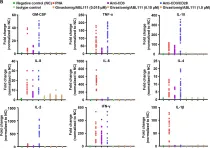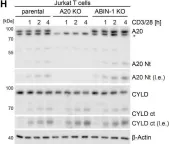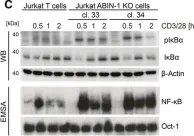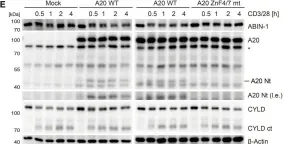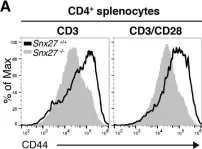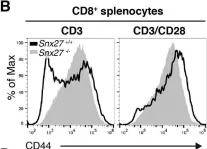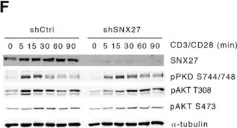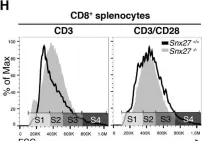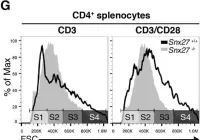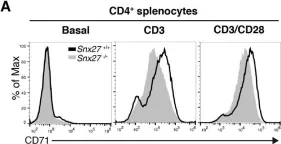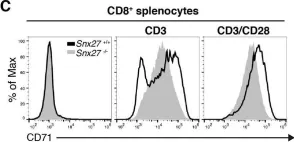Cytotoxic CD8 T lymphocytes (CTL) are crucial in antiviral immune responses. However, their recruitment to infection sites renders them at risk of viral infection that could modulate their effector activity. CTL express RIG-I that detects cytosolic viral RNA and subsequently induce antiviral gene expression. Here, we investigated how influenza A virus (IAV) infection influence TCR-dependent effector responses. IAV infection of CTL stimulated RIG-I, and activated downstream pathways including TBK1 and NF-ϰB, resulting in type-I interferon secretion. Transfection of CTL with a pure RIG-I ligand, tri-phosphorylated double stranded RNA(3p-dsRNA), not only stimulated these pathways but also enhanced CTL proliferation in vitro and protected them from IAV infection. Analogous with a positive effect on CD8 effector function, both IAV infection and RIG-I ligand transfection enhanced CTL degranulation and cytokine secretion. Conversely, activation of CTL via CD3/CD28-crosslinking increased their susceptibility to IAV infection. Altogether, RIG-I stimulation either by IAV infection or 3p-dsRNA transfection promoted cell intrinsic antiviral pathways and enhanced CD8 effector functions. These findings suggest that RIG-I agonists could enhance and prolong CTL effector function in immunotherapy.
Product Citations: 181
RIG-I Stimulation Enhances Effector Function and Proliferation of Primary Human CD8 T Cells
Preprint on BioRxiv : the Preprint Server for Biology on 29 January 2025 by Mohamed, A. A., Wallerath, C., et al.
-
Immunology and Microbiology
In Oncology Letters on 1 January 2025 by Jiang, R., Jin, B., et al.
Ovarian cancer is the third most common gynecological malignancy worldwide and the fifth leading cause of cancer-related death among women. This may be attributed to difficulties in diagnosing early-stage ovarian cancer, as it is typically asymptomatic until metastases, and due to the ineffective management of patients with late-stage ovarian cancer. The aim of the present study was to investigate potential therapeutic targets for the treatment of ovarian cancer. Bioinformatics techniques were used to analyze the expression levels of tryptophan (Trp) metabolism-related genes in tissue samples from patients with ovarian cancer. Additionally, western blots, clonogenic assays, immunohistochemical staining, chromatin immunoprecipitation-quantitative PCR, cell co-culture assays, a xenograft model and high-performance liquid chromatography-tandem mass spectrometry were performed to evaluate the antitumor effects of genes identified from the bioinformatics analysis. Increased expression levels of the amino acid transporter, solute carrier family 7 member 5 (SLC7A5), in tissue samples from patients with ovarian cancer was demonstrated. Inhibition of SLC7A5 reduced ovarian cancer cell proliferation through G2/M cell cycle arrest and blocked intracellular aryl hydrocarbon receptor nucleus entry, which downregulated PD-L1 expression levels. Dysregulation of Trp metabolism in ovarian cancer tissue samples, as well as the upregulation of kynurenine expression levels in the plasma of patients with ovarian cancer, were demonstrated to be unfavorable prognostic factors for the progression-free survival of patients with ovarian cancer. The present study demonstrated that the dysregulation of Trp metabolism could potentially be used as a diagnostic biomarker for ovarian cancer, as well as the potential of targeting SLC7A5 for immunotherapeutic management of patients with ovarian cancer in the future.
Copyright: © 2024 Jiang et al.
-
Cancer Research
In Cell Reports Medicine on 17 December 2024 by Zhou, S., Lin, W., et al.
Glioblastoma (GBM) stem cells (GSCs) contribute to poor prognosis in patients with GBM. Identifying molecular markers is crucial for developing targeted therapies. Here, we identify cluster of differentiation 97 (CD97) as an optimal GSC surface antigen for potential targeting by chimeric antigen receptor (CAR) T cell therapy through in vitro antibody screening. CD97 is consistently expressed in all validated patient-derived GSCs and positively correlated with known intracellular GSC markers. Silencing CD97 reduces GSC tumorigenicity-related activities, including self-renewal, proliferation, and tumor progression. Transcriptome analysis reveals that CD97 activates mTORC2, leading to AKT S473 phosphorylation and enhanced expression of the downstream genes ARHGAP1, BZW1, and BZW2. Inhibiting mTORC2 with JR-AB2-011 suppresses GSC tumorigenicity and downstream gene expression. We develop CD97-CAR T helper (Th) 9 cells, which exhibit potent cytotoxic effects in vitro and extend survival in mice. These findings suggest that CD97 is a promising GSC-enriched antigen and that targeting it with CAR Th9 cells offers a potential therapeutic strategy for GBM.
Copyright © 2024 The Author(s). Published by Elsevier Inc. All rights reserved.
-
Stem Cells and Developmental Biology
AMPK activation induces RALDH+ tolerogenic dendritic cells by rewiring glucose and lipid metabolism.
In The Journal of Cell Biology on 7 October 2024 by Brombacher, E. C., Patente, T. A., et al.
Dendritic cell (DC) activation and function are underpinned by profound changes in cellular metabolism. Several studies indicate that the ability of DCs to promote tolerance is dependent on catabolic metabolism. Yet the contribution of AMP-activated kinase (AMPK), a central energy sensor promoting catabolism, to DC tolerogenicity remains unknown. Here, we show that AMPK activation renders human monocyte-derived DCs tolerogenic as evidenced by an enhanced ability to drive differentiation of regulatory T cells, a process dependent on increased RALDH activity. This is accompanied by several metabolic changes, including increased breakdown of glycerophospholipids, enhanced mitochondrial fission-dependent fatty acid oxidation, and upregulated glucose catabolism. This metabolic rewiring is functionally important as we found interference with these metabolic processes to reduce to various degrees AMPK-induced RALDH activity as well as the tolerogenic capacity of moDCs. Altogether, our findings reveal a key role for AMPK signaling in shaping DC tolerogenicity and suggest AMPK as a target to direct DC-driven tolerogenic responses in therapeutic settings.
© 2024 Brombacher et al.
-
Biochemistry and Molecular biology
-
Cell Biology
-
Immunology and Microbiology
In Scientific Reports on 14 May 2024 by Blake, D., Gazzara, M. R., et al.
The length of 3' untranslated regions (3'UTR) is highly regulated during many transitions in cell state, including T cell activation, through the process of alternative polyadenylation (APA). However, the regulatory mechanisms and functional consequences of APA remain largely unexplored. Here we present a detailed analysis of the temporal and condition-specific regulation of APA following activation of primary human CD4+ T cells. We find that global APA changes are regulated temporally and CD28 costimulatory signals enhance a subset of these changes. Most APA changes upon T cell activation involve 3'UTR shortening, although a set of genes enriched for function in the mTOR pathway exhibit 3'UTR lengthening. While upregulation of the core polyadenylation machinery likely induces 3'UTR shortening following prolonged T cell stimulation; a significant program of APA changes occur prior to cellular proliferation or upregulation of the APA machinery. Motif analysis suggests that at least a subset of these early changes in APA are driven by upregulation of RBM3, an RNA-binding protein which competes with the APA machinery for binding. Together this work expands our understanding of the impact and mechanisms of APA in response to T cell activation and suggests new mechanisms by which APA may be regulated.
© 2024. The Author(s).
-
Immunology and Microbiology
In J Immunother Cancer on 1 June 2023 by Gao, J., Wang, Z., et al.
Fig.6.B

-
FC/FACS
-
Collected and cropped from J Immunother Cancer by CiteAb, provided under a CC-BY license
Image 1 of 16
In Cell Mol Life Sci on 31 January 2022 by Yin, H., Karayel, Ö., et al.
Fig.3.H

-
WB
-
Collected and cropped from Cell Mol Life Sci by CiteAb, provided under a CC-BY license
Image 1 of 16
In Cell Mol Life Sci on 31 January 2022 by Yin, H., Karayel, Ö., et al.
Fig.3.C

-
WB
-
Collected and cropped from Cell Mol Life Sci by CiteAb, provided under a CC-BY license
Image 1 of 16
In Cell Mol Life Sci on 31 January 2022 by Yin, H., Karayel, Ö., et al.
Fig.4.K

-
WB
-
Collected and cropped from Cell Mol Life Sci by CiteAb, provided under a CC-BY license
Image 1 of 16
In Cell Mol Life Sci on 31 January 2022 by Yin, H., Karayel, Ö., et al.
Fig.6.E

-
WB
-
Collected and cropped from Cell Mol Life Sci by CiteAb, provided under a CC-BY license
Image 1 of 16
In Sci Rep on 27 November 2017 by Tello-Lafoz, M., Rodríguez-Rodríguez, C., et al.
Fig.5.A

-
FC/FACS
-
Mus musculus (House mouse)
Collected and cropped from Sci Rep by CiteAb, provided under a CC-BY license
Image 1 of 16
In Sci Rep on 27 November 2017 by Tello-Lafoz, M., Rodríguez-Rodríguez, C., et al.
Fig.5.B

-
FC/FACS
-
Mus musculus (House mouse)
Collected and cropped from Sci Rep by CiteAb, provided under a CC-BY license
Image 1 of 16
In Sci Rep on 27 November 2017 by Tello-Lafoz, M., Rodríguez-Rodríguez, C., et al.
Fig.5.E

-
WB
-
Homo sapiens (Human)
Collected and cropped from Sci Rep by CiteAb, provided under a CC-BY license
Image 1 of 16
In Sci Rep on 27 November 2017 by Tello-Lafoz, M., Rodríguez-Rodríguez, C., et al.
Fig.5.F

-
WB
-
Homo sapiens (Human)
Collected and cropped from Sci Rep by CiteAb, provided under a CC-BY license
Image 1 of 16
In Sci Rep on 27 November 2017 by Tello-Lafoz, M., Rodríguez-Rodríguez, C., et al.
Fig.8.B

-
FC/FACS
-
Mus musculus (House mouse)
Collected and cropped from Sci Rep by CiteAb, provided under a CC-BY license
Image 1 of 16
In Sci Rep on 27 November 2017 by Tello-Lafoz, M., Rodríguez-Rodríguez, C., et al.
Fig.8.H

-
FC/FACS
-
Mus musculus (House mouse)
Collected and cropped from Sci Rep by CiteAb, provided under a CC-BY license
Image 1 of 16
In Sci Rep on 27 November 2017 by Tello-Lafoz, M., Rodríguez-Rodríguez, C., et al.
Fig.8.G

-
FC/FACS
-
Mus musculus (House mouse)
Collected and cropped from Sci Rep by CiteAb, provided under a CC-BY license
Image 1 of 16
In Sci Rep on 27 November 2017 by Tello-Lafoz, M., Rodríguez-Rodríguez, C., et al.
Fig.8.A

-
FC/FACS
-
Mus musculus (House mouse)
Collected and cropped from Sci Rep by CiteAb, provided under a CC-BY license
Image 1 of 16
In Sci Rep on 27 November 2017 by Tello-Lafoz, M., Rodríguez-Rodríguez, C., et al.
Fig.7.A

-
FC/FACS
-
Collected and cropped from Sci Rep by CiteAb, provided under a CC-BY license
Image 1 of 16
In Sci Rep on 27 November 2017 by Tello-Lafoz, M., Rodríguez-Rodríguez, C., et al.
Fig.7.C

-
FC/FACS
-
Collected and cropped from Sci Rep by CiteAb, provided under a CC-BY license
Image 1 of 16
In PLoS One on 28 January 2014 by Sakamoto, T., Kobayashi, M., et al.
Fig.1.C

-
WB
-
Collected and cropped from PLoS One by CiteAb, provided under a CC-BY license
Image 1 of 16
